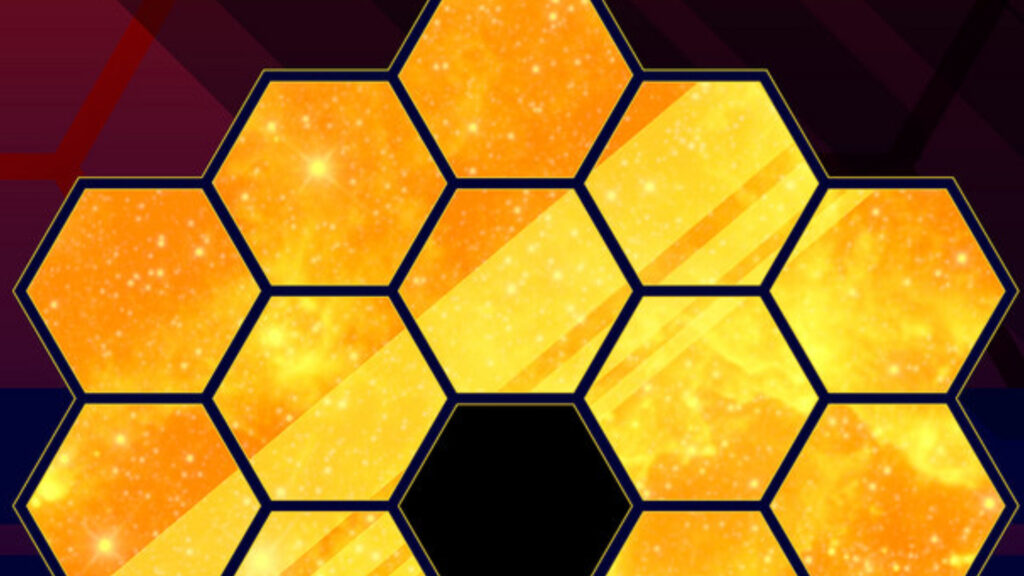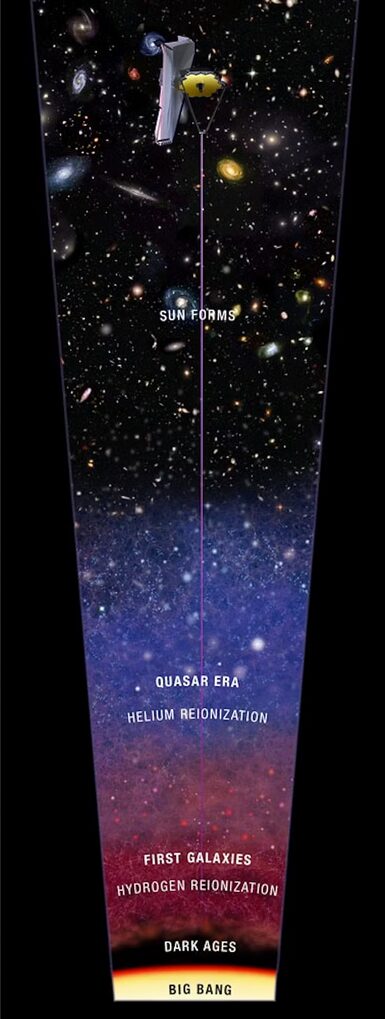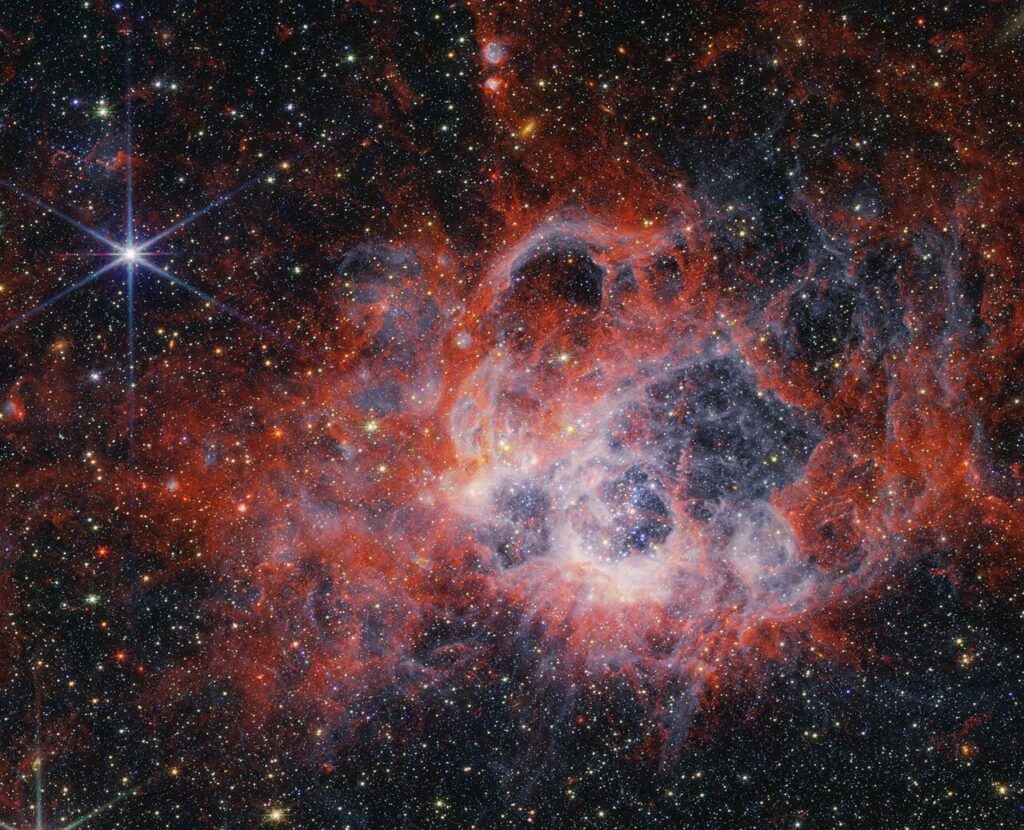James Webb is the ultimate in space telescopes, thanks to a very large primary mirror. This allows it to capture the light emitted by objects that are very far away in the universe, and in time. This article from The Conversation looks at the possibility of going back even further — including to the Big Bang.
The James Webb Space Telescope (JWST) is one of the most advanced telescopes ever built. Its planning began more than 25 years ago and construction spanned more than a decade. It was launched into space on December 25, 2021, and a month later it arrived at its final destination: 930,000 miles from Earth [environ 1,5 million de km, NDLR]. Its position in space allows it to have a relatively clear view of the universe.
The telescope’s design is a global effort, led by NASA, to push the boundaries of astronomical observation through revolutionary engineering. Its mirror is gigantic: it measures approximately 6.5 meters in diameter. It’s almost three times the size of the Hubble Space Telescope, which was launched in 1990 and still operates today.
It is the mirror of a telescope that allows it to collect light. The JWST is so large that it can “see” the faintest and most distant galaxies and stars in the universe. Its cutting-edge instruments can reveal information about the composition, temperature and motion of these distant cosmic objects.
As an astrophysicist, I continually look into the past to see what stars and galaxies looked like when their light began its journey to Earth, and I use this information to better understand their growth and evolution. For me, and for thousands of space scientists, the James Webb Space Telescope is a window into this unknown universe.
How far back into the cosmos and the past can the JWST reach? About 13.5 billion years old.

A space telescope that allows you to go back in time
A telescope does not show stars, galaxies and exoplanets as they are today. Instead, astronomers have a glimpse of what they were like in the past. It takes time for light to travel through space and reach our telescopes. Looking into space is also traveling in time.
This is even true for objects that are very close to us. The light you see from the Sun is 8 minutes and 20 seconds old. This is the time it takes to reach our eyes.
You can easily do the math. All light – whether it’s sunlight, a flashlight, or a light bulb in your home – travels at a speed of about 300,000 kilometers per second. That’s just over 18 million kilometers per minute. The Sun is about 150 million kilometers from Earth. This is approximately 8 minutes and 20 seconds.
But the further away an object is, the longer it takes for its light to reach us. This is why the light from Proxima Centauri, the closest star to us after the Sun, is four years old, that is, it is about 40 trillion kilometers from Earth and that its light takes a little over four years to reach us. Or, as scientists like to say, four light years.
More recently, JWST observed Earendel, one of the most distant stars ever detected. The light that the JWST sees from Earendel is about 12.9 billion years old.
James Webb can look much further back in time than previously possible with other telescopes, such as the Hubble Space Telescope. The JWST can see objects almost nine times fainter than Hubble.
Can we go back to the beginning of time — to the Big Bang?


But is it possible to go back to the beginning of time?
The Big Bang is a term used to define the beginning of the universe as we know it. Scientists believe it occurred around 13.8 billion years ago. It is the theory most widely accepted by physicists to explain the history of our universe.
The name is a bit misleading, however, as it suggests that some sort of explosion, like fireworks, created the universe. The Big Bang more accurately represents the appearance of rapidly expanding space throughout the universe. Immediately after the Big Bang, the environment was like a cosmic fog that covered the universe, preventing light from traveling beyond. Eventually, galaxies, stars, and planets began to expand.
This is why this period of the universe is called the “Dark Ages.” As the universe expanded, the cosmic fog began to clear and light was eventually able to travel freely through space. In fact, a few satellites observed the light left behind by the Big Bang, about 380,000 years after it happened. These telescopes were built to detect the afterglow of the Big Bang, the light of which can be tracked in the microwave range.
However, even 380,000 years after the Big Bang, there were no stars or galaxies. The universe was still very dark. The period of cosmic darkness did not end until a few hundred million years later, when the first stars and galaxies began to form.


The James Webb Space Telescope was not designed to observe the Big Bang, but rather the period when the first objects in the universe began to form and emit light. Before this period, it can observe little light, given the conditions of the early universe and the absence of galaxies and stars.
To observe the period close to the Big Bang, it is not enough to have a larger mirror: astronomers have already done it using other satellites which observe the emission of microwaves very shortly after the Big Bang. Bang. So the fact that the James Webb Space Telescope observes the universe a few hundred million years after the Big Bang is not a limitation of the telescope. Rather, it is a mission of the telescope. It is a reflection of the place in the universe where the first light from stars and galaxies is expected to emerge.
By studying ancient galaxies, scientists hope to understand the unique conditions of the early universe and better understand the processes that helped them flourish. This includes the evolution of supermassive black holes, the life cycle of stars, and the composition of exoplanet worlds beyond our solar system.


Adi Foord, Assistant Professor of Astronomy and Astrophysics, University of Maryland, Baltimore County
This article is republished from The Conversation under a Creative Commons license. Read the original article.
Do you want to know everything about the mobility of tomorrow, from electric cars to e-bikes? Subscribe now to our Watt Else newsletter!
